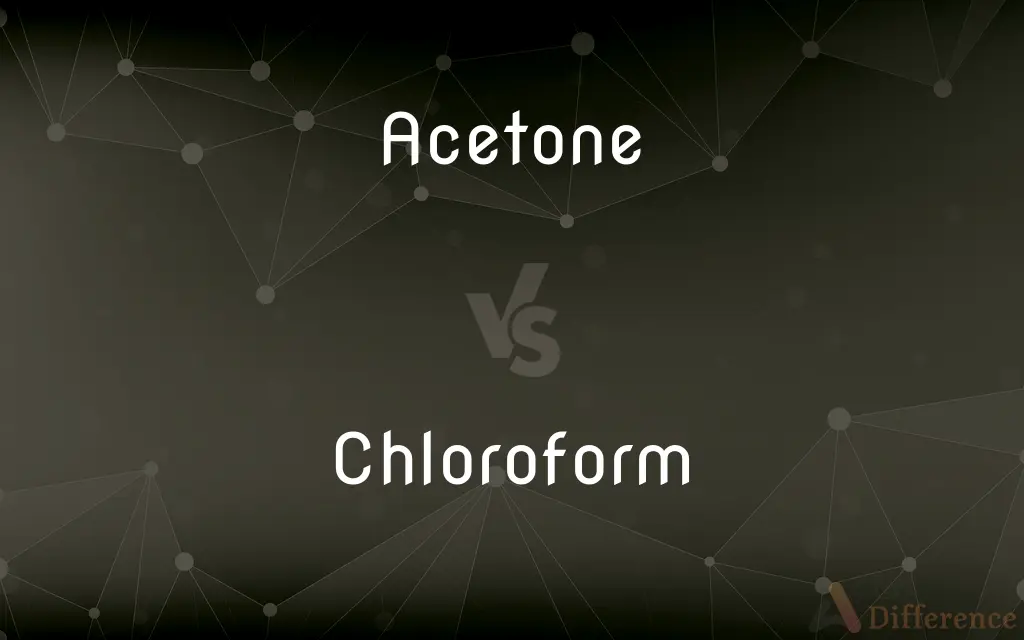Acetone vs. Chloroform — What's the Difference?
By Urooj Arif & Fiza Rafique — Updated on March 27, 2024
Acetone is a solvent known for its quick evaporation and mildness, widely used in nail polish remover, while chloroform is a heavier, sedative chemical used historically in anesthesia.

Difference Between Acetone and Chloroform
Table of Contents
ADVERTISEMENT
Key Differences
Acetone is a highly volatile, flammable solvent commonly used in the beauty industry, especially in nail polish removers, due to its effectiveness in dissolving organic compounds. Whereas chloroform, with its heavier and sedative properties, has a historical significance in medical anesthesia but is less common today due to its health risks.
Acetone is produced both naturally and synthetically, playing a significant role in biological processes and industrial applications, including as a solvent in the manufacture of plastics and other synthetic materials. On the other hand, chloroform is produced mainly through the chlorination of methane and has applications in refrigeration, as well as being a solvent for fats, oils, rubbers, and alkaloids.
Due to its low boiling point, acetone evaporates quickly at room temperature, making it ideal for fast-drying applications. Conversely, chloroform has a higher boiling point, leading to slower evaporation and making it useful in applications requiring a stable solvent over time.
Acetone is considered less toxic and safer for general use, with proper ventilation reducing potential health risks. However, chloroform is recognized for its potential health hazards, including its role as a carcinogen and the risks associated with its inhalation, ingestion, or skin contact.
Despite their differences, both acetone and chloroform share the commonality of being organic solvents with significant industrial and laboratory applications. Their distinct chemical properties dictate their specific uses, with acetone being favored for its quick evaporation and chloroform for its efficacy as a solvent in specialized situations.
ADVERTISEMENT
Comparison Chart
Primary Use
Nail polish remover, industrial solvent
Anesthesia (historically), industrial solvent
Chemical Structure
Simplest ketone, with a carbonyl group
Contains three chlorine atoms and one carbon atom
Boiling Point
Lower (~56°C)
Higher (~61°C)
Toxicity
Generally low toxicity
High toxicity, potential carcinogen
Evaporation Rate
Fast
Slower
Compare with Definitions
Acetone
Plays a role in metabolic processes.
Acetone can be produced in the human body during ketosis.
Chloroform
A substance that induces insensitivity to pain.
Historically, chloroform was used as an anesthetic during surgeries.
Acetone
An organic compound characterized by a carbonyl group bonded to two hydrocarbon groups.
Acetone is the simplest form of ketone.
Chloroform
A liquid substance capable of dissolving other substances.
Chloroform can dissolve many organic compounds, making it useful in laboratories.
Acetone
A substance used to dissolve other substances.
Acetone is often used as a solvent to remove nail polish.
Chloroform
Having the potential to cause cancer.
Chloroform has been identified as a potential carcinogen by research studies.
Acetone
Easily evaporable at normal temperatures.
Acetone's volatile nature makes it evaporate quickly when exposed to air.
Chloroform
A compound containing one or more halogen atoms.
Chloroform is a halogenated compound, with chlorine as the halogen.
Acetone
Man-made through chemical synthesis.
Acetone is produced synthetically for industrial use.
Chloroform
A substance used in cooling mechanisms.
Chloroform has been used as a refrigerant due to its chemical properties.
Acetone
Acetone, or propanone, is an organic compound with the formula (CH3)2CO. It is the simplest and smallest ketone. It is a colourless, highly volatile and flammable liquid with a characteristic pungent odour.
Chloroform
Chloroform, or trichloromethane, is an organic compound with formula CHCl3. It is a colorless, strong-smelling, dense liquid that is produced on a large scale as a precursor to PTFE. It is also a precursor to various refrigerants.
Acetone
(organic compound) A colourless, volatile, flammable liquid ketone, (CH3)2CO, used as a solvent.
Chloroform
A clear, colorless, dense, sweet-smelling liquid, CHCl3, used in refrigerants, propellants, and resins, as a solvent, and sometimes as an anesthetic. Chloroform, once widely used in human and veterinary surgery, has generally been replaced by less toxic, more easily controlled agents.
Acetone
A volatile liquid consisting of three parts of carbon, six of hydrogen, and one of oxygen; pyroacetic spirit, - obtained by the distillation of certain acetates, or by the destructive distillation of citric acid, starch, sugar, or gum, with quicklime.
Chloroform
To apply chloroform to.
Acetone
The simplest ketone; a highly inflammable liquid widely used as an organic solvent and as material for making plastics
Chloroform
(organic compound) A halogenated hydrocarbon, trichloromethane, CHCl3; it is a volatile, sweet-smelling liquid, used extensively as a solvent and formerly as an anesthetic.
Chloroform
To treat with chloroform, or to render unconscious with chloroform.
Chloroform
A colorless volatile liquid, CHCl3, having an ethereal odor and a sweetish taste, formed by treating alcohol with chlorine and an alkali. It is a powerful solvent of wax, resin, etc., and is extensively used to produce anæsthesia in surgical operations; also externally, to alleviate pain.
Chloroform
To treat with chloroform, or to place under its influence.
Chloroform
A volatile liquid haloform (CHCl3); formerly used as an anesthetic;
Chloroform was the first inhalation anesthetic
Chloroform
Anesthetize with chloroform;
Doctors used to put people under by chloroforming them
Common Curiosities
Are acetone and chloroform safe to use?
Acetone is generally safe with proper handling, while chloroform should be used with caution due to its higher toxicity.
What makes chloroform a good solvent?
Its ability to dissolve organic compounds and fats makes it a valuable solvent in various applications.
Can acetone and chloroform be found in nature?
Acetone can be produced naturally in plants and animals, whereas chloroform can occur in small amounts in the environment but is mainly produced industrially.
What safety precautions should be taken when using acetone?
Use in a well-ventilated area, avoid skin contact, and keep away from open flames.
Is chloroform still used for anesthesia?
No, due to its health risks, chloroform is no longer widely used for anesthesia.
What are the main uses of acetone?
Acetone is primarily used as a solvent in the beauty industry and in the production of plastics and synthetic fibers.
How does chloroform exposure affect the body?
Exposure can lead to central nervous system depression, liver and kidney damage, and potentially cancer.
What are the boiling points of acetone and chloroform?
Acetone boils at approximately 56°C, while chloroform boils at about 61°C.
How do acetone and chloroform affect human health?
Acetone is less toxic and usually safe in small amounts, whereas chloroform exposure can lead to serious health issues, including cancer.
Can acetone dissolve plastics?
Yes, acetone can dissolve certain types of plastics, making it useful for cleaning and dissolving purposes.
How is acetone produced?
Acetone is produced both naturally and synthetically through the cumene process.
Can acetone be used in food applications?
No, acetone is not safe for ingestion and should not be used in food applications.
What are the environmental impacts of chloroform?
Chloroform can contribute to air and water pollution and is regulated due to its potential environmental and health impacts.
Why was chloroform replaced as an anesthetic?
Due to its toxic side effects and the development of safer alternatives.
What are the signs of acetone exposure?
Inhalation can cause throat irritation, dizziness, and headache, while skin contact can lead to dryness and irritation.
Share Your Discovery

Previous Comparison
Mono vs. Stereo
Next Comparison
Polyol vs. AlditolAuthor Spotlight
Written by
Urooj ArifUrooj is a skilled content writer at Ask Difference, known for her exceptional ability to simplify complex topics into engaging and informative content. With a passion for research and a flair for clear, concise writing, she consistently delivers articles that resonate with our diverse audience.
Co-written by
Fiza RafiqueFiza Rafique is a skilled content writer at AskDifference.com, where she meticulously refines and enhances written pieces. Drawing from her vast editorial expertise, Fiza ensures clarity, accuracy, and precision in every article. Passionate about language, she continually seeks to elevate the quality of content for readers worldwide.














































